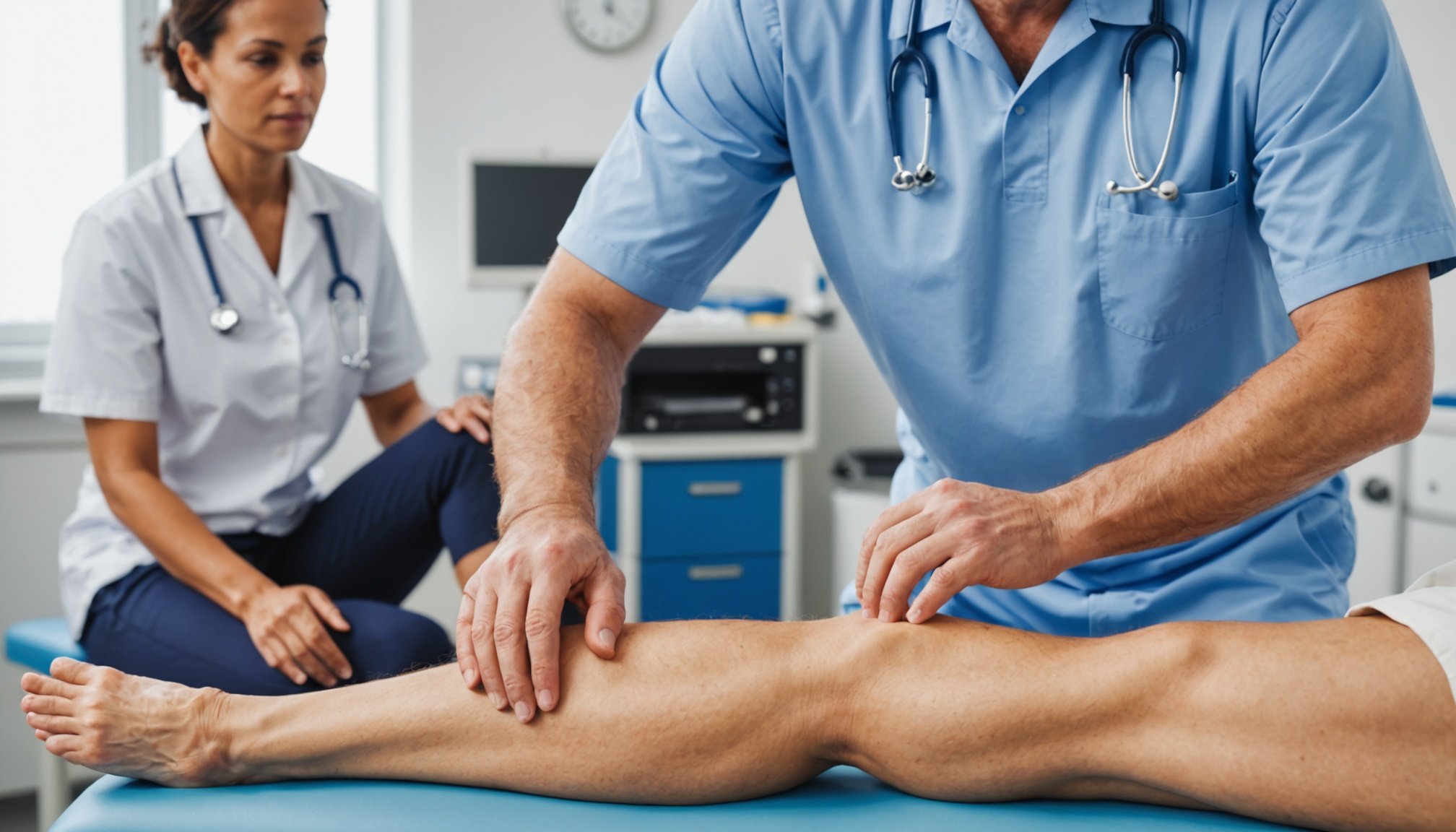Overview of Post-Operative Care for Knee Replacement Patients
Navigating the rehabilitation process after knee replacement surgery is crucial for achieving optimal results. Post-operative care is not one-size-fits-all; it requires individualized care plans tailored to the patient’s specific needs and health status. These plans ensure that patients receive the right interventions at the right time, thus facilitating a smoother recovery.
A key element of post-operative care is understanding the typical recovery timeline. Generally, patients can expect to spend the first few days post-surgery in the hospital, focusing on pain management and beginning basic movement exercises. Within the first 1-2 weeks, they often engage in regular physical therapy sessions to enhance mobility and strength, progressing to more independent movement over the next few months. Full recovery can range from 6 months to a year, depending on various factors.
Also to see : Essential Strategies for UK Optometrists to Combat Rising Digital Eye Strain Among Young Adults
Several factors can influence post-operative outcomes, including age, overall health, and adherence to the rehabilitation plan. Healthier individuals might experience quicker recovery periods, whereas others may require a more extended rehabilitation process. Compliance with outlined exercises and precautions is of utmost importance to ensure a successful post-operative experience. Engaging in communication with healthcare professionals can further assist in tailoring the recovery process to individual needs.
Evidence-Based Rehabilitation Techniques
Utilizing evidence-based rehabilitation techniques allows practitioners to deliver effective and tailored interventions for diverse patient needs. It ensures that physiotherapy modalities and exercise protocols are optimally used for each individual, enhancing recovery outcomes.
In parallel : Strategies for UK Pediatricians to Combat Vitamin D Deficiency in Exclusively Breastfed Infants
Early Mobilization Strategies
Early mobilization is crucial in rehabilitation. It minimizes muscle atrophy and joint stiffness, promoting faster recovery. Implementing strategies such as assisted walking or cycling can stimulate circulation and prevent complications. Importantly, early movement addresses pain management and mobility, helping patients regain functional independence sooner.
Manual Therapy Approaches
Manual therapy can be an integral part of rehabilitation. Techniques such as joint mobilizations and soft tissue manipulation are vital for improving joint function and alleviating pain. These hands-on methods enhance the body’s natural healing processes, making them beneficial when combined with other physiotherapy modalities.
Strengthening and Flexibility Exercises
Incorporating strengthening and flexibility exercises is essential for restoring physical capacity post-injury. Resistance training should be tailored to each patient, adjusting exercise intensity and volume to suit their recovery stage. Ensuring a balance between strength and flexibility aids in achieving a comprehensive recovery, reducing the risk of future injuries.
Role of Patient Education
Patient education plays a pivotal role in ensuring a successful recovery. When individuals are actively involved in their recovery process, they tend to have better outcomes. Before any surgical procedure, pre-operative preparation is essential. This preparation includes educating patients about the procedure, the expected outcomes, and any potential complications. Setting realistic expectations helps patients mentally prepare for what lies ahead, which can reduce anxiety and foster a positive mindset.
Moreover, providing patients with self-management tips empowers them to take charge of their post-operative care. Teaching simple yet effective strategies for managing pain, following post-surgery instructions, and identifying warning signs early can significantly impact the recovery trajectory. Access to resources, such as educational brochures or online platforms, offers ongoing support and ensures that patients have the information they need at their fingertips.
Incorporating patient education into pre-operative preparation and the recovery process creates an environment where patients feel supported and informed. This approach not only enhances the quality of care but also promotes patient satisfaction and leads to an overall improvement in health outcomes. Encouraging patient engagement through education is a vital component of modern healthcare.
Measuring Outcomes and Effectiveness
The ability to measure rehabilitation effectiveness is crucial in understanding how well treatments are working for patients. Accurate outcomes measurement is key to this understanding, as it allows healthcare providers to track progress, adapt interventions, and ultimately enhance patient satisfaction.
Key Performance Indicators
Key Performance Indicators (KPIs) are vital metrics used to evaluate the success of rehabilitation processes. These could include improvements in mobility, pain reduction, or even patient-reported satisfaction. Each KPI provides insight into how effectively a physiotherapy program is meeting its goals, helping practitioners to make informed decisions.
Patient-Reported Outcome Measures
Patient-Reported Outcome Measures (PROMs) are a valuable tool for capturing the patient’s perspective on their own health and treatment satisfaction. By collecting data directly from the patient, healthcare providers can personalize treatment plans to better meet individual needs, thus increasing overall satisfaction and effectiveness.
Tracking Progress Over Time
It’s essential to continuously track progress through standardized assessment tools. Such tools can identify whether the set goals are being accomplished. By adjusting care based on outcome data, practitioners can optimize the individualized treatment plans, ensuring that measurable goals are met efficiently. This ongoing assessment plays a pivotal role in confirming that the chosen interventions are effective, securing a high level of patient satisfaction.
Regulatory Considerations and Best Practices
Navigating the landscape of regulatory considerations is essential for professionals aiming to adhere to ethical standards and uphold quality care. Each locality has its own regulations that impact practice. Understanding these rules is crucial, as non-compliance can lead to significant legal and professional consequences.
Incorporating ethical practices in patient care is more than just following rules—it’s about ensuring respect, dignity, and confidentiality for patients. This involves consistent application of ethical principles such as informed consent and autonomy. By focusing on ethical practices, professionals reinforce trust and credibility with their clients.
To effectively manage both regulatory and ethical considerations, best practice guidelines serve as a lifeline. They provide a framework to ensure that care is both up-to-date and effective. Staying informed about the latest best practices is imperative, as this not only enhances compliance but also boosts the overall quality of care provided.
Professionals should continuously update their knowledge on professional guidelines and standards. Workshops, webinars, and professional journals can be excellent resources for staying abreast of changes and innovations in the field. By integrating these insights into daily practice, professionals demonstrate commitment to excellence and continuous improvement.
Utilizing Local Resources and Support Networks
In the realm of rehabilitation and patient care, leveraging local resources can significantly enhance recovery outcomes.
Collaboration with Local Healthcare Providers
Collaboration with local healthcare providers is vital for holistic care. By fostering partnerships with physiotherapy networks and clinics, patients gain access to a coordinated care approach. This ensures that all healthcare needs are addressed, promoting an environment where patients feel supported and understood.
Accessing Community Rehabilitation Services
Community rehabilitation services are invaluable assets for both patients and caregivers. Such services provide a comprehensive range of therapies and recovery programs tailored to individual needs. The availability of resources like specialized physiotherapy networks enhances the accessibility and effectiveness of these programs.
Building Support Networks for Patients
Developing robust support networks is critical for anyone undergoing significant healthcare procedures. Multidisciplinary teamwork not only optimizes treatment outcomes but also reinforces the emotional and mental fortitude of patients. Identifying and connecting patients with local services and peer support groups can significantly reduce the isolation felt during recovery. Strategies may include:
- Introducing patients to community support events
- Connecting with online forums specific to their health challenges
- Encouraging participation in local support group meetings
These efforts can effectively bridge gaps between medical care and emotional support, fostering a comprehensive healing environment.
Case Studies and Real-Life Examples
Exploring real-life examples is vital for understanding the transformative potential of rehabilitation. Success stories demonstrate how rehabilitation can make a substantial difference in individuals’ lives, offering lessons learned and proven strategies.
Successful Rehabilitation Cases
Case studies provide concrete evidence of how targeted interventions can aid recovery. For instance, one study showcased an athlete who, after a severe knee injury, returned to peak performance through a customised rehabilitation programme. This programme focused on strength training and mobility, highlighting innovative approaches that cater to individual needs.
Lessons Learned from Practice
From these practical examples, several lessons emerge. Consistency and a personalised plan are crucial for effective rehabilitation. Case studies underscore the importance of adapting methods to suit unique circumstances, ensuring optimal results.
Innovative Approaches in Real-Life Scenarios
Real-life examples reveal how innovative strategies, such as incorporating technology in rehabilitation, create more dynamic recovery paths. Wearable devices, for example, monitor progress and deliver real-time feedback, enhancing the rehabilitation process.
These practical examples and case studies teach us that while rehabilitation is a challenge, well-tailored strategies can successively overcome it, restoring quality of life to those affected.











